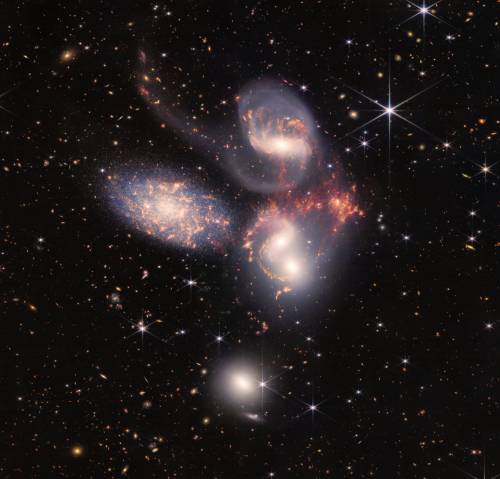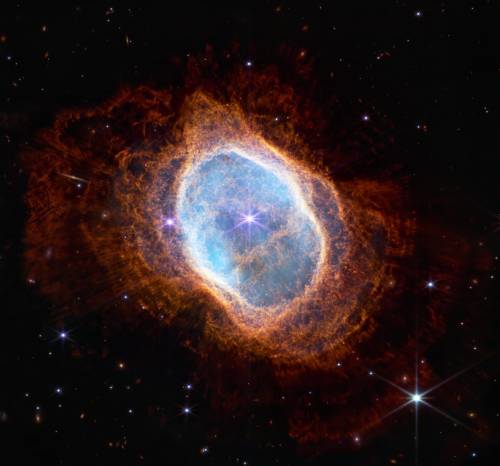Celebrate #BlackHoleFriday With Nurturing Baby Stars
Celebrate #BlackHoleFriday with Nurturing Baby Stars

Are you throwing all your money into a black hole today?
Forget Black Friday — celebrate #BlackHoleFriday with us and get sucked into this recent discovery of a black hole that may have sparked star births across multiple galaxies.
If confirmed, this discovery would represent the widest reach ever seen for a black hole acting as a stellar kick-starter — enhancing star formation more than one million light-years away. (One light year is equal to 6 trillion miles.)
A black hole is an extremely dense object from which no light can escape. The black hole’s immense gravity pulls in surrounding gas and dust. Sometimes, black holes hinder star birth. Sometimes — like perhaps in this case — they increase star birth.
Telescopes like our Chandra X-ray Observatory help us detect the X-rays produced by hot gas swirling around the black hole. Have more questions about black holes? Click here to learn more.
Make sure to follow us on Tumblr for your regular dose of space: http://nasa.tumblr.com.
More Posts from Primordialbitch and Others
did humans invent math or did we discover it
does math even exist



Black Hole Image Makes History; NASA Telescopes Coordinated Observations
A black hole and its shadow have been captured in an image for the first time, a historic feat by an international network of radio telescopes called the Event Horizon Telescope (EHT). EHT is an international collaboration whose support in the U.S. includes the National Science Foundation.
A black hole is an extremely dense object from which no light can escape. Anything that comes within a black hole’s “event horizon,” its point of no return, will be consumed, never to re-emerge, because of the black hole’s unimaginably strong gravity. By its very nature, a black hole cannot be seen, but the hot disk of material that encircles it shines bright. Against a bright backdrop, such as this disk, a black hole appears to cast a shadow.
The stunning new image shows the shadow of the supermassive black hole in the center of Messier 87 (M87), an elliptical galaxy some 55 million light-years from Earth. This black hole is 6.5 billion times the mass of the Sun. Catching its shadow involved eight ground-based radio telescopes around the globe, operating together as if they were one telescope the size of our entire planet.
“This is an amazing accomplishment by the EHT team,” said Paul Hertz, director of the astrophysics division at NASA Headquarters in Washington. “Years ago, we thought we would have to build a very large space telescope to image a black hole. By getting radio telescopes around the world to work in concert like one instrument, the EHT team achieved this, decades ahead of time.”
To complement the EHT findings, several NASA spacecraft were part of a large effort, coordinated by the EHT’s Multiwavelength Working Group, to observe the black hole using different wavelengths of light. As part of this effort, NASA’s Chandra X-ray Observatory, Nuclear Spectroscopic Telescope Array (NuSTAR) and Neil Gehrels SwiftObservatory space telescope missions, all attuned to different varieties of X-ray light, turned their gaze to the M87 black hole around the same time as the Event Horizon Telescope in April 2017. If EHT observed changes in the structure of the black hole’s environment, data from these missions and other telescopes could be used to help figure out what was going on.
While NASA observations did not directly trace out the historic image, astronomers used data from NASA’s Chandra and NuSTAR satellites to measure the X-ray brightness of M87’s jet. Scientists used this information to compare their models of the jet and disk around the black hole with the EHT observations. Other insights may come as researchers continue to pore over these data.
There are many remaining questions about black holes that the coordinated NASA observations may help answer. Mysteries linger about why particles get such a huge energy boost around black holes, forming dramatic jets that surge away from the poles of black holes at nearly the speed of light. When material falls into the black hole, where does the energy go?
“X-rays help us connect what’s happening to the particles near the event horizon with what we can measure with our telescopes,” said Joey Neilsen, an astronomer at Villanova University in Pennsylvania, who led the Chandra and NuSTAR analysis on behalf of the EHT’s Multiwavelength Working Group.
NASA space telescopes have previously studied a jet extending more than 1,000 light-years away from the center of M87. The jet is made of particles traveling near the speed of light, shooting out at high energies from close to the event horizon. The EHT was designed in part to study the origin of this jet and others like it. A blob of matter in the jet called HST-1, discovered by Hubble astronomers in 1999, has undergone a mysterious cycle of brightening and dimming.
Chandra, NuSTAR and Swift, as well as NASA’s Neutron star Interior Composition Explorer (NICER) experiment on the International Space Station, also looked at the black hole at the center of our own Milky Way galaxy, called Sagittarius A*, in coordination with EHT.
Getting so many different telescopes on the ground and in space to all look toward the same celestial object is a huge undertaking in and of itself, scientists emphasize.
“Scheduling all of these coordinated observations was a really hard problem for both the EHT and the Chandra and NuSTAR mission planners,” Neilsen said. “They did really incredible work to get us the data that we have, and we’re exceedingly grateful.”
Neilsen and colleagues who were part of the coordinated observations will be working on dissecting the entire spectrum of light coming from the M87 black hole, all the way from low-energy radio waves to high-energy gamma rays. With so much data from EHT and other telescopes, scientists may have years of discoveries ahead.
Original article:
http://nasa.gov/mission_pages/chandra/news/black-hole-image-makes-history
Time And Space







Extinct tree grows anew from ancient jar of seeds unearthed by archaeologists
by Stephen Messenger
“For thousands of years, Judean date palm trees were one of the most recognizable and welcome sights for people living in the Middle East — widely cultivated throughout the region for their sweet fruit, and for the cool shade they offered from the blazing desert sun.
From its founding some 3,000 years ago, to the dawn of the Common Era, the trees became a staple crop in the Kingdom of Judea, even garnering several shout-outs in the Old Testament. Judean palm trees would come to serve as one of the kingdom’s chief symbols of good fortune; King David named his daughter, Tamar, after the plant’s name in Hebrew.
By the time the Roman Empire sought to usurp control of the kingdom in 70 AD, broad forests of these trees flourished as a staple crop to the Judean economy — a fact that made them a prime resource for the invading army to destroy. Sadly, around the year 500 AD, the once plentiful palm had been completely wiped out, driven to extinction for the sake of conquest.
In the centuries that followed, first-hand knowledge of the tree slipped from memory to legend. Up until recently, that is.
During excavations at the site of Herod the Great’s palace in Israel in the early 1960’s, archeologists unearthed a small stockpile of seeds stowed in a clay jar dating back 2,000 years. For the next four decades, the ancient seeds were kept in a drawer at Tel Aviv’s Bar-Ilan University. But then, in 2005, botanical researcher Elaine Solowey decided to plant one and see what, if anything, would sprout.
“I assumed the food in the seed would be no good after all that time. How could it be?“ said Solowey. She was soon proven wrong.
Amazingly, the multi-millennial seed did indeed sprout — producing a sapling no one had seen in centuries, becoming the oldest known tree seed to germinate.
Today, the living archeological treasure continues to grow and thrive; In 2011, it even produced its first flower — a heartening sign that the ancient survivor was eager to reproduce. It has been proposed that the tree be cross-bred with closely related palm types, but it would likely take years for it to begin producing any of its famed fruits. Meanwhile, Solowey is working to revive other age-old trees from their long dormancy.”
***Does anyone in the know have any comments?
(Source: Tree Hugger)
Neutron Stars Collide
The recent detection of two neutron stars colliding has sent waves through spacetime and the astronomical community.
You may have seen headlines in the news and not really know why this is such a big deal.
Here’s the Sparknotes version:
A while back a thing called “gravitational waves” were observed for the first time. These are fluctuations in the fabric of spacetime that propagate out from their source just like light, i.e. radially/like a pebble dropped in water. General relativity shows us that the acceleration of objects with mass cause this event to occur.
Until fairly recently these have been too difficult to observe and in fact Einstein didn’t think we’d ever be able to. A series of laser interferometers have disproved that assumption. Using high-precision analysis of how the lasers shift as a gravitational wave moves through them scientists can now see the small movements in the universe that are gravitational waves.
Importantly, we now have three such observatories capable of working together. Known as the “LIGO-Virgo” team, two observatories in the U.S. and one in Italy detected these shifting in spacetime. Three is a pretty magical number in coordinating detections like this because you can then triangulate where the signal comes from and…
BINGO! Within hours optical observatories were zeroing in on the predicted source of these spacetime fluctuations. Indeed, they confirmed the presence of a previously unseen glow:

What you’re looking at is the glow of two neutron stars colliding into each other. This explosion has the energy of approximately 260,000,000 suns.
Each of these stars has such a large mass that the waves in spacetime are actually detectable from a distance of 140 million light-years away.
Impressive, right? Although you might agree, this still begs the question of what exactly we’ve learned from this event. Well - a lot. Since this is the first observation we have made with both gravitational wave observatories and more traditional astronomical observatories (i.e. light detecting ones) we’ve been able to put some numbers on the phenomenon. Here are some of the things we’ve learned:
1) Gravitational waves propagate at the speed of light!
2) A huge portion of heavier elements (like gold and uranium!) may have their origins in neutron star collisions! Nuclear synthesis in stars more typical like the sun is restricted to closer to 10% of the star’s mass being able to fuse elements together into new ones. This process is actually quite inefficient (actually, YOU are a more efficient radiator than the sun!) and it becomes more difficult for a star to fuse the heavier elements. Before this event we didn’t have a good way of explaining why we found so much more heavy stuff than stellar nuclear synthesis could account for. Now? Baboom! This neutron star collision resulted in the synthesis of so much gold that it’s about 150 times more massive than the Earth! Cha-Ching!
So if you’re an amateur (or professional, I suppose) astronomer and you want to see this collision, now dubbed GW170817, and you build a little radio telescope (another post!), you’ll be able to detect this collision for the next 5-10 years due to the afterglow.
(Image credit: NASA and ESA)



NASA’s Webb Space Telescope Reveals Astounding, Unprecedented Views of the Universe
TRAILER: “AFTER WE LEAVE” (2019)
Written and Directed by Aleem Hossain, “After We Leave” is a gritty sci-fi feature film about a man who has a once-in-a-lifetime chance to emigrate off Earth… only if he can find his estranged wife and convince her to come with him.
Winner: Best Feature Film at Sci Fi London Winner: Best Director at Berlin Sci Fi Film Fest



A Russian zoo is home to a unique animal - the liger. It is half-lioness, half-tiger. Mother Zita is pictured licking her one month old liliger cub
How do blackholes form and how do they move ?
TRAILER: “TIME MASTERS (LES MAÎTRES DU TEMPS)” (1982)
This animated science fiction feature film was directed by René Laloux and Tibor Hernádi but most notably - designed by the artist Mœbius. It is based on Stefan Wul’s 1958 science fiction novel L'Orphelin de Perdide (The Orphan of Perdide).
It’s about a boy, Piel, who is stranded on the desert planet Perdide, where giant killer hornets live. He awaits rescue by the space pilot Jaffar, the exiled prince Matton, his sister Belle and Jaffar’s old friend Silbad - who are all trying to reach Perdide and save Piel before it is too late.
If you’ve seen this film, you’ve probably seen the English language dubs by the BBC in 1987 or 1991 called Time Masters.
This is a super rare film that you can find on DVD, but usually used, and pretty expensive.
-
 filnetwdedoctloc liked this · 1 year ago
filnetwdedoctloc liked this · 1 year ago -
 vexalia liked this · 2 years ago
vexalia liked this · 2 years ago -
 spaceman-of-space reblogged this · 3 years ago
spaceman-of-space reblogged this · 3 years ago -
 sociallyawkwardbirb liked this · 4 years ago
sociallyawkwardbirb liked this · 4 years ago -
 primordialbitch reblogged this · 5 years ago
primordialbitch reblogged this · 5 years ago -
 adiposeclot liked this · 5 years ago
adiposeclot liked this · 5 years ago -
 brickonthemoon liked this · 5 years ago
brickonthemoon liked this · 5 years ago -
 notcouchtato2398 liked this · 5 years ago
notcouchtato2398 liked this · 5 years ago -
 cherryobvious liked this · 5 years ago
cherryobvious liked this · 5 years ago -
 ad-astra-per-aspera-80 reblogged this · 5 years ago
ad-astra-per-aspera-80 reblogged this · 5 years ago -
 216-11 liked this · 5 years ago
216-11 liked this · 5 years ago -
 spaciegracie07 liked this · 5 years ago
spaciegracie07 liked this · 5 years ago -
 lotusroyals liked this · 5 years ago
lotusroyals liked this · 5 years ago -
 roogranger liked this · 5 years ago
roogranger liked this · 5 years ago -
 avaant-gaarde liked this · 5 years ago
avaant-gaarde liked this · 5 years ago -
 interdimensionalfractal liked this · 5 years ago
interdimensionalfractal liked this · 5 years ago -
 themostpowerfulmutant liked this · 5 years ago
themostpowerfulmutant liked this · 5 years ago -
 miguelvicentevidal liked this · 5 years ago
miguelvicentevidal liked this · 5 years ago -
 myrathepeach liked this · 5 years ago
myrathepeach liked this · 5 years ago -
 unknown-uwoit liked this · 5 years ago
unknown-uwoit liked this · 5 years ago -
 tenebrobscuro reblogged this · 5 years ago
tenebrobscuro reblogged this · 5 years ago -
 tenebrobscuro liked this · 5 years ago
tenebrobscuro liked this · 5 years ago -
 jungkookstigerlily liked this · 5 years ago
jungkookstigerlily liked this · 5 years ago -
 steadyfisheclipsepaper liked this · 5 years ago
steadyfisheclipsepaper liked this · 5 years ago -
 greatzoologyaestheticartisan liked this · 5 years ago
greatzoologyaestheticartisan liked this · 5 years ago -
 cmonboard liked this · 5 years ago
cmonboard liked this · 5 years ago -
 chickenscratch42 liked this · 5 years ago
chickenscratch42 liked this · 5 years ago -
 draco-sarcastic liked this · 5 years ago
draco-sarcastic liked this · 5 years ago -
 lovingherwasgay liked this · 5 years ago
lovingherwasgay liked this · 5 years ago
